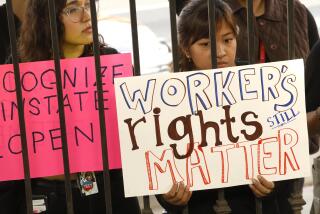Lawmakers cast a cool eye on museum spending
- Share via
WASHINGTON — To New York officials, the $3 million in federal economic stimulus money they received to transform an old canal boat into a 259-foot-long floating museum was money well spent.
“Its very presence on the canal brings new life to the waterfront,” said Craig Williams, a historian at the New York State Museum.
But to some in Washington, it’s a symbol of pork-barrel excess that taxpayers can ill afford in a time of record budget deficits.
“Should we build a museum when we have roads in disrepair?” Sen. Tom Coburn (R-Okla.) asked.
In the last four years, Coburn said, $28 million has gone to fund 55 transportation museums. And millions more have gone to other kinds of museums.
Such spending is drawing new scrutiny after money went to institutions such as the Atomic Testing Museum in Las Vegas, the National Corvette Museum in Kentucky, the Hunting and Fishing Museum of Pennsylvania, and the Los Angeles County Fire Museum in Bellflower.
“We have to ask ourselves: Is this of national significance?” said Leslie Paige of the watchdog group Citizens Against Government Waste.
House leaders have told lawmakers that museums won’t be a high priority in the new transportation funding bill. The last such measure included money for the National Packard Museum in Warren, Ohio, and the Henry Ford Museum in Dearborn, Mich.
Some spending bills moving through Congress contain money for museums -- including $930,000 for the Aerospace Museum of California near Sacramento, $350,000 for the Museum of Aviation in Georgia and $100,000 for the Cape Cod Maritime Museum. The Senate defense bill includes $25 million to expand the National World War II Museum in New Orleans. But congressional leaders denied a lawmaker’s request for money for a New York museum dedicated to “the history and evolution of the North American maple syrup industry.”
Supporters of museum funding said it was even more important in a tough economy.
“The fact that some in Congress still don’t understand all the ways museums enrich our communities -- as educators, as stewards of history and culture, and as economic engines -- is cause for concern,” Ford W. Bell, president of the American Assn. of Museums, said in an e-mail response to a recent Senate effort to cut museum funding.
“Our job is to educate,” said Patricia Mooradian, president of the nonprofit Henry Ford Museum, which received about $1.2 million in the last transportation bill. “It’s so important for people to learn about the past, to learn about culture and heritage and what made this country great.”
Rep. Jeff Flake (R-Ariz.), a leading critic of pork-barrel spending, argued that “you can justify anything if economic development is the objective.”
And Rep. John Campbell (R-Irvine) likened federal support for local museum projects to supporting a charity. “Is that what people elected me and my colleagues to do, to take their tax money and make charitable contributions with it?” he asked.
At the Corvette museum, Executive Director Wendell Strode said the $198,000 the facility received to install driving simulators would help motorists, especially teens, “perfect their skills in challenging and potentially dangerous situations prior to experiencing those in real life” and reduce the risk of accidents.
“When we speak about transportation improving the quality of life, it’s not just about building roads and bridges,” Federal Highway Administration spokeswoman Cathy St. Denis said.
The nonprofit Aerospace Museum of California would use the $930,000 to restore and maintain military planes on display at the former McClellan Air Force Base, said Executive Director Roxanne Yonn.
“Many of the students we serve and will be able to serve have never seen an airplane up close, much less been in one,” she said, calling the planes “classrooms.”
Although Coburn specifically criticized the spending of stimulus funds to convert the 1921 canal boat, the Day Peckinpaugh, into a traveling museum, New York officials say the project has generated jobs. The museum, designed to tell the story of the Erie Canal and other waterways, has also generated excitement, they say.
“When you see the kids go into the cargo hold, you see a sense of awe,” said Williams, the historian.
--
More to Read
Sign up for Essential California
The most important California stories and recommendations in your inbox every morning.
You may occasionally receive promotional content from the Los Angeles Times.











